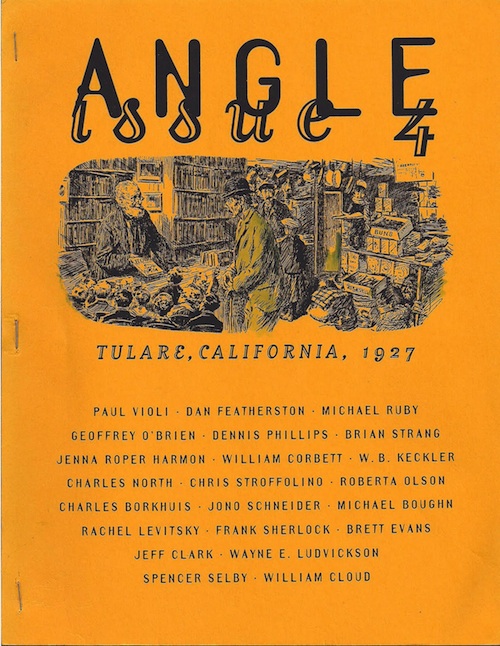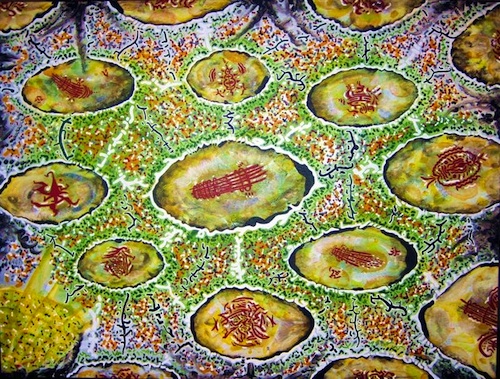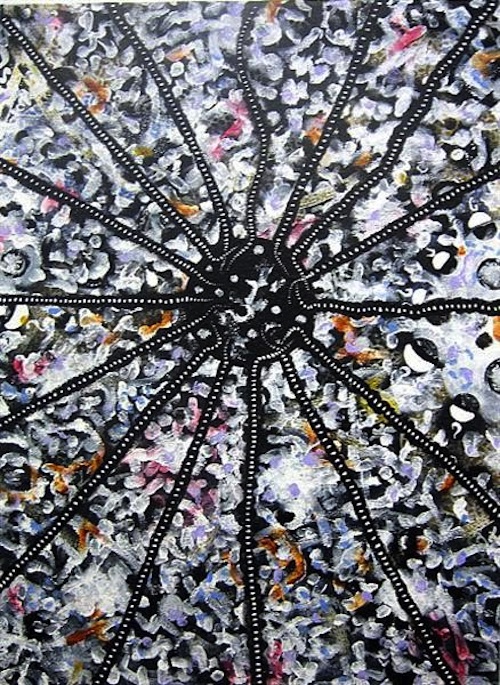The Art of Doing Other Shit: Harry Smith, Brian Lucas
I remember, not exactly when, but the feeling of when I first realized the Harry Smith behind the Anthology of American Folk Music (1952) was also the Harry Smith who made Early Abstractions (1964) and other avant-garde films. Then I remember having the feeling again when I went to the James Cohen Gallery in NY in 2002 to see a show of his paintings called The Heavenly Tree Grows Downward. According to the catalog, Smith considered painting his primary vocation, which was striking as he’s much more central to the histories of film and popular music. (A lot of rock & roll, for example, through the folk music revival, springs directly from Smith’s LPs.) But the assertion made sense to me standing in front of his art; the intensity of meticulous obsession radiating off the works was palpable. They often have an astonishing formal intricacy yet their inspiration clearly lies elsewhere than in formal innovation—in, for example, his readings on occult subjects—making him marginal to art history. But art history is sometimes a dumb way to look at art, if it prevents you from engaging with Harry Smith’s paintings.
As a poet, I’ve always drawn inspiration from artists who practice different categories of art, that is, not simply the poet who writes fiction or the painter who collages but the artist who moves from the verbal to the visual, or vice versa, or from either to the musical. I love, for instance, the fact that David Meltzer led a psychedelic folk-rock group in the late ’60s, or that he made collages in the ’70s, one of which graces the cover of the next City Lights Spotlight book, Micah Ballard’s Waifs and Strays. (He also did the cover of Micah’s previous book, Parish Krewes (Bootstrap Productions, 2009), but I couldn’t resist tapping him for the new one, to infuse his ambiance into the series.) The recent death of Leonora Carrington reminds me of the role such protean activity plays in the history of surrealism, for not only is she among the many important painters associated with the original group but she’s also one of its most significant fiction writers, in books like The Oval Lady (1975) and The Hearing Trumpet (1976). Many of the assemblages André Breton made under the rubric “poem-objects” have the enigmatic beauty of Cornell boxes, Jean Arp’s poetry alone would make him a major surrealist, while Duchamp’s forays into optics and professional chess bespeak a whole other level of commitment to promiscuity. On the home front I think of Barbara Guest’s abstract collages, many of which became covers for her later books, and, when all is said and done, the most influential writer of the NY School after O’Hara and Ashbery may in fact be the artist Joe Brainard, purely on the strength of I Remember (1970).
As a poet, critic, and all-around man-of-letters, I write frequently but I can’t write constantly; particularly after finishing a large prose work under deadline, I need a few days off, and I’ve generally found making visual art to be a good way to recharge the battery. When I was a kid, I used to draw all the time, often copying photographs of people I admired (I remember drawing many pictures of the Beatles, for example, around age 9). Considering I was self-taught, I was very good at rendering a likeness, but I’ve lost the patience and inspiration. Drawing is about as natural as breathing to me, but all I do is doodle now, usually when I’m on the phone or taking notes. But the visual impulse has assumed various, more deliberate artistic forms over the years, including collages, photography, linoleum cuts, and digital videos. In most cases, the work of a particular artist has set me off. I started making collages, for instance, after reading Max Ernst’s collage novel, Une semaine de bonté (1934), while my first forays into b&w photography were inspired, curiously enough, by Man Ray’s films, attempting to apply the principles of light and darkness I gleaned from them. Making videos was a different story; my inspiration here came from film rather than video itself, being interested primarily in shooting and editing. For me, cutting between shots was the pinnacle of my experiences making non-written art, and the skill later came in handy when I first started writing about Bay Area rap in 2005. This was before videocameras and editing software really hit the ghetto in Oakland—it’s a small industry now—so I wound up shooting and/or editing a handful of videos for free, under the pseudonym Hyphy Scrilliams. At the time I just felt like making videos, but I wound up meeting endless rappers and other industry types this way, establishing a wide network of contacts that’s been crucial to my life as a music journalist, though I’ve long since hung up the director’s quirt.
In any case, while I’ve done some interesting pieces here and there, I’m ultimately a writer who makes visual art rather than a visual artist. I don’t nearly have the level of obsession and expertise with the visual that I do with writing. What amazes me most, therefore, are those artists who somehow fully commit themselves to more than one form of art. A poet I know, Brian Lucas, is a case in point, for seldom have I known anyone with the wherewithal to simultaneously pursue poetry, painting, and music with equal intensity. When we met in 1997, Brian was publishing a stapled magazine called Angle, an account of which, complete with pdfs of all issues, can be found here. (One of my collages graces the cover of issue 4.) He was also in an improvisational rock band called Mirza that used to gig around SF and released an album, Anadromous (Darla Records, 1997), whose cover and inner sleeve he drew. He was a painter, and he’d been writing poetry far longer than I. He hadn’t even gone to college and I was middle-class enough to be shocked by this. I was in grad school at Berkeley at the time, partly because I didn’t know how else to obtain knowledge of things like poetry, and here was this self-educated guy who knew way more about it. Together we met Jeff Clark, and our collective output (particularly Jeff’s magazine Faucheuse) caused enough upset at the time to be denounced as “Northern California Surrealism” by a professor or two. It seems so funny now, but that’s how it was the ’90s.
In early 2001, however, Brian packed up and moved to Thailand; he was visiting friends in Bangkok, and found he could make a living there teaching English. I think the initial plan was to do this for a year or two, but 9/11 might have changed that, given its effect on the character of American public life and political discourse. The country he left no longer existed. And he began developing roots, eventually getting married in an elaborate traditional Thai ceremony. I thought he was gone for good.
But in 2007, along with his wife Nisa, Brian returned to the Bay Area and now they live literally down the street from me in Oakland. I’d say it’s like he never left, except if you look at his canvases you know it’s not true. He’d already become a good artist before he left, but the six years he spent in Thailand proved transformative to his work, which I followed from a distance online (and now here). As I wrote in a review of a 2008 gallery show:
Lucas’ abstractions accrue in obsessively worked increments. Whereas in his earlier work these parts formed discrete centers of interest, his more recent paintings, like the acrylic Correspondence [pictured above], reveal a more unified sense of composition, their lush brightness influenced by his six-year stay in Thailand . . . with an illusion of depth hitherto unrealized.
A couple of years later, when I needed some sufficiently cosmic cover art for the third volume of the Spotlight poetry series, Andrew Joron’s Trance Archive (City Lights, 2010), Brian was the obvious choice. He and Andrew are friends and had just collaborated on a book of poems and drawings for Hooke Press called Force Fields (2010). And along with a third poet, Joseph Noble, author of An Ives Set (lyric&, 2006), they play together in an improvisational ambient trio called Cloud Shepherd. Joe plays reeds and flute, Andy’s on theremin, and Brian switches among 6-string bass, treated cassette-tapes, and effects-laden microphones placed in paper towel tubes, buckets of dry leaves, or any other miniature sound environment he can cook up. They work along that twilight border where music meets pure sound and are about to release a CD, Helioscript, on the Bay Area experimental music label, Auricular Records. (Other sessions can be downloaded free at the group’s Bandcamp page.)
Despite all these doings, Brian remains a poet. In 2006, while he was still in Thailand, he published his first book, Light House (Meeting Eyes Bindery), and more recently has published a chapbook, Telepathic Bones (Berkeley Neo-Baroque, 2011), in which the visionary irrational imagery of his earlier work is further realized:
I am emerald green
veined with catalysts
an all-seeing eye
burned to a crispThey found one part
of my brain
in the recent excavation
of a lunar lodgefrom the other half
has sprung a tree
At this point, I would be less astonished at seeing a tree grow from Brian’s brain as I already am at the varied forms of art that spring from there.
Garrett Caples is the author of Lovers of Today (2021), Power Ballads (2016), Retrievals (2014), Quintessence...
Read Full Biography




